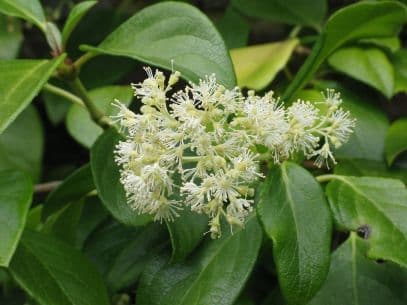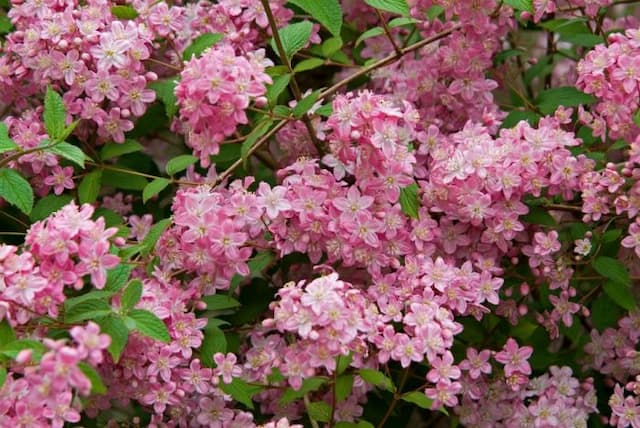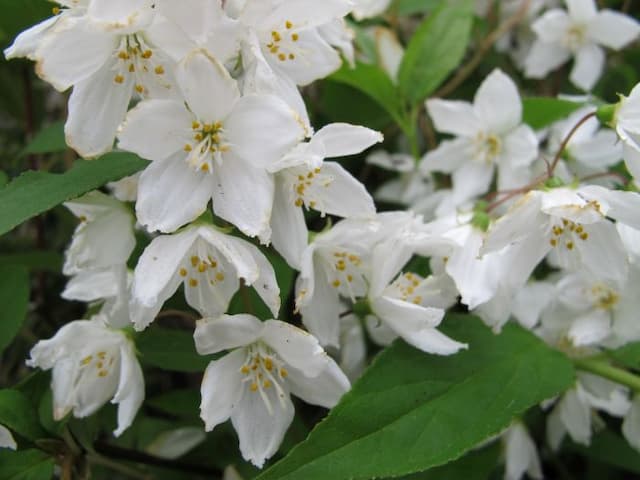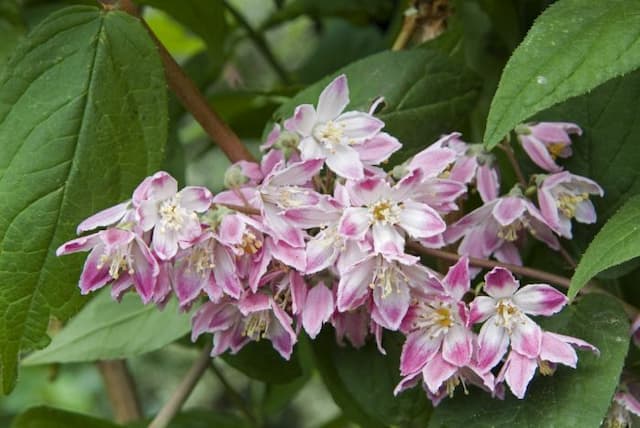Bigleaf Hydrangea Hydrangea macrophylla Colorado = 'Raco' (PBR) (River-line Series) (H)

ABOUT
The Hydrangea macrophylla 'Raco', commonly known as Hydrangea, is a striking shrub renowned for its appealing foliage and large, rounded flower clusters. Its leaves are deep green and glossy, often with slightly serrated edges, which create a lush backdrop for the blooms. The flowers are the main attraction, typically changing color throughout the season depending on the soil pH, from rich blues to vibrant pinks or creamy whites. These blossoms form generous, globe-shaped flower heads that are composed of numerous smaller florets, giving the plant a full and opulent appearance. This Hydrangea's blooms make it a favorite among gardeners and are commonly used in both fresh and dried floral arrangements. The plant as a whole presents a classic, yet bold statement in any garden setting, attracting attention with its vibrant colors and substantial flowering heads.
About this plant
 Names
NamesFamily
Hydrangeaceae.
Synonyms
Bigleaf Hydrangea, French Hydrangea, Lacecap Hydrangea, Mophead Hydrangea, Penny Mac, Hortensia.
Common names
Hydrangea macrophylla Colorado.
 Toxicity
ToxicityTo humans
Hydrangeas, including the Hydrangea macrophylla or Bigleaf Hydrangea, contain cyanogenic glycosides, which can release cyanide when chewed or digested. If ingested in large enough quantities, this can lead to poisoning. Symptoms of hydrangea poisoning may include stomach upset, nausea, vomiting, and diarrhea. In severe cases, ingestion can result in dizziness, rapid pulse, drop in blood pressure, and convulsions, but such extreme cases are rare.
To pets
Hydrangeas, known commonly as Bigleaf Hydrangeas, are toxic to pets, including cats and dogs, due to the presence of cyanogenic glycosides found in the plant's leaves and blooms. If pets consume parts of hydrangeas, they may exhibit symptoms of poisoning such as vomiting, diarrhea, lethargy, and depression. In severe cases, ingestion could lead to more serious symptoms like confusion, an increased heart rate, and seizures, although serious incidents are uncommon with only mild ingestions.
 Characteristics
CharacteristicsLife cycle
Perennials
Foliage type
Deciduous
Color of leaves
Green
Flower color
Varies
Height
3-4 feet [0.9-1.2 meters]
Spread
3-4 feet [0.9-1.2 meters]
Plant type
Shrub
Hardiness zones
5-9
Native area
Japan
Benefits
 General Benefits
General Benefits- Attractive Flowers: Hydrangea 'Raco' is known for its large, showy flowers that can range in color from blue to pink depending on soil pH, providing visual interest in gardens and landscapes.
- Seasonal Interest: This plant typically blooms from early summer to late fall, offering a long period of visual appeal through its flowering season.
- Easy to Grow: Hydrangeas are generally easy to care for and can thrive in a range of soil types, though they prefer moist, well-drained soil.
- Versatile Landscaping: Can be used in a variety of landscaping situations including border plantings, as a specimen plant, or in mass plantings for a dramatic effect.
- Attracts Pollinators: The flowers are attractive to bees and other pollinators, which is beneficial for the ecosystem and helps in the pollination of nearby plants.
- Adaptable to Pruning: Hydrangea 'Raco' responds well to pruning, which can be used to control its shape and size, making it suitable for different garden designs and spaces.
- Hardy: It has a good level of resistance to cold temperatures and can survive in USDA zones 5-9, making it adaptable to various climates.
 Medical Properties
Medical PropertiesThis plant is not used for medical purposes.
 Air-purifying Qualities
Air-purifying QualitiesThis plant is not specifically known for air purifying qualities.
 Other Uses
Other Uses- Aluminum detection: The flower color of the hydrangea can be indicative of soil pH and the presence of aluminum ions, making it a natural indicator for gardeners and soil scientists.
- Watercolor dye: The petals of the hydrangea can be used to create a delicate watercolor dye for artwork and fabric dyeing due to their range of colors.
- Crafting material: Dried hydrangea flowers are popular in floral arrangements, wreaths, and other dried flower crafts due to their appealing shape and longevity.
- Culinary decoration: While not edible, hydrangea flowers can be used as a non-toxic decoration for cakes and desserts, which should be removed before consumption.
- Inspiration for artists: The vibrant and varied colors of hydrangeas often inspire artists and can be featured in paintings, textile designs, and other artistic creations.
- Photography: Hydrangeas, with their full blooms, make attractive subjects and backgrounds for both professional and amateur photographers.
- Garden design: Hydrangeas are used in landscape design for color themes due to their variety of colors and the ability to change color based on soil treatment.
- Education tool: Hydrangeas can serve as a hands-on educational tool to teach children about plant biology, pollination, and the impact of soil conditions on plant health.
- Rain gauge: Due to their broad leaves, hydrangeas can be used to observe and approximate the amount of rainfall in a garden.
- Animal habitat: Dense hydrangea shrubs can provide shelter and nesting spots for small birds and beneficial garden insects.
Interesting Facts
 Feng Shui
Feng ShuiThe Hydrangea is not used in Feng Shui practice.
 Zodiac Sign Compitability
Zodiac Sign CompitabilityThe Hydrangea is not used in astrology practice.
 Plant Symbolism
Plant Symbolism- Heartfelt Emotions: Hydrangeas are often associated with the expression of deep emotions, thanks to their lush and abundant blooms, making them a popular gift to express gratitude, understanding, or heartfelt joy.
- Gratitude and Apology: In some cultures, the hydrangea can symbolize an apology or a thank you for being understood, possibly stemming from their opulent and generous appearance that suggests an overflow of feelings.
- Vanity and Boastfulness: Some interpretations of the hydrangea's symbolism point to vanity and boastfulness due to their extensive clusters of flowers and showy presence in a garden.
- Perseverance: The robust nature of hydrangeas, particularly their ability to rebound from harsh conditions, makes them a symbol of perseverance and determination.
- Frigidity and Heartlessness: Despite their lush appearance, the hydrangea can sometimes represent frigidity or lack of empathy in certain contexts, possibly due to the plant's earlier associations in historical folklore.
- Fourth Wedding Anniversary: Hydrangeas are commonly associated with the fourth wedding anniversary, symbolizing appreciation and lasting gratitude, as well as the growth and development of a couple's love over time.
 Water
WaterBigleaf Hydrangeas should be watered thoroughly about three times a week, providing enough water to keep the soil moist but not waterlogged. In hotter weather or during dry spells, increase watering to maintain moisture levels. Typically, this equates to about 1 gallon per plant for each watering session, depending on the climate and soil drainage.
 Light
LightBigleaf Hydrangeas thrive in partial shade with morning sun and afternoon shade being ideal. Direct afternoon sunlight can be too intense and lead to leaf scorch, while too much shade can reduce flowering. A spot that receives dappled sunlight throughout the day is best for balanced growth and blooming.
 Temperature
TemperatureBigleaf Hydrangeas prefer a temperature range between 65°F and 75°F for optimal growth but can survive in temperatures as low as 5°F and as high as 95°F. However, protecting the plant from frost is essential to prevent damage to the buds and stems.
 Pruning
PruningPruning Bigleaf Hydrangeas is important for removing dead wood, shaping the plant, and encouraging new growth. Prune just after flowering, typically in late summer or early fall, cutting back flowering stems to the first pair of healthy buds. Do not prune in late fall or winter, as this can remove next season's flower buds.
 Cleaning
CleaningAs needed
 Soil
SoilThe best soil mix for Hydrangeas, commonly known as mophead hydrangeas, should be rich in organic matter, have good drainage, and consistently moist. A mixture of loamy soil, peat, and perlite or coarse sand can work well. The soil pH should be adjusted to around 5.5 for blue flowers or closer to 6.5 for pink flowers, as soil acidity affects bloom color.
 Repotting
RepottingMophead hydrangeas, including the Colorado variety, generally need repotting every 2-3 years or when the roots outgrow the pot. Choose a slightly larger pot and fresh soil to ensure continued health and growth.
 Humidity & Misting
Humidity & MistingMophead hydrangeas thrive in environments with moderate to high humidity. They prefer humidity levels between 40% to 70%. Consistently moist air without being overly wet is suitable for their optimal growth.
 Suitable locations
Suitable locationsIndoor
Place in bright indirect light, keep soil moist, and provide high humidity.
Outdoor
Plant in partial shade, shelter from afternoon sun, ensure moist, rich soil.
Hardiness zone
6-9 USDA
 Life cycle
Life cycleHydrangea macrophylla Colorado begins its life as a dormant bare-root plant or from cuttings which then germinate and develop into young seedlings, establishing a strong root system. As spring arrives, it enters a vegetative stage characterized by rapid leaf growth due to favorable conditions like moist soil and partial sun. The plant then transitions to the flowering stage in early to mid-summer, producing large, showy mophead blooms that can vary in color from pink to blue depending on soil pH. After blooming, it enters a period of energy accumulation in late summer and fall, during which time it stores nutrients in its woody stems and root system for the following year. In the fall, the plant's foliage may change color before it sheds leaves and enters dormancy, a survival strategy for enduring the winter. Upon the return of warmer temperatures in spring, the cycle restarts as the hydrangea breaks dormancy and new growth emerges from the buds that overwintered on the stems.
 Propogation
PropogationPropogation time
Spring to Summer
The most popular method for propagating Hydrangea macrophylla, commonly known as bigleaf hydrangea, is through softwood or semi-hardwood cuttings. This typically occurs during late spring or early summer, when new growth is still tender but has started to mature. Cut a 4 to 6 inch (approximately 10 to 15 cm) piece from a healthy branch, making sure it includes at least three sets of leaves. Remove the lower leaves, and if desired dip the cut end into rooting hormone to encourage root development. Plant the cutting in a moist, well-draining potting mix, ensuring at least two sets of leaf nodes are below the surface. Keep the soil consistently damp and provide indirect light until roots establish, which usually takes a few weeks to a couple of months depending on conditions.






![Rose deutzia [Yuki Cherry Blossom]](/_next/image?url=https%3A%2F%2Fplants-admin.emdemapps.com%2Fimages%2Fplants%2F%2Fimages%2F604b6510a383a.png&w=640&q=75)

![Hydrangea [Hot Chocolate]](/_next/image?url=https%3A%2F%2Fplants-admin.emdemapps.com%2Fimages%2Fplants%2F%2Fimages%2F604b5a066e3bd.png&w=640&q=75)
![Hydrangea [Blackberry Pie]](/_next/image?url=https%3A%2F%2Fplants-admin.emdemapps.com%2Fimages%2Fplants%2F%2Fimages%2F604b56e2abc1d.png&w=640&q=75)